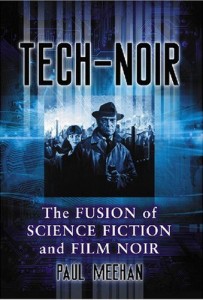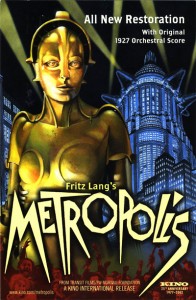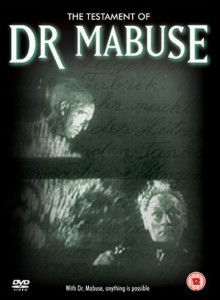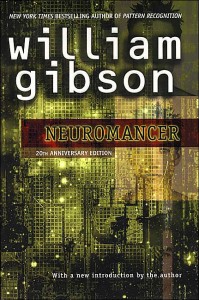 Paul Meehan is a friend and frequent source for interesting explorations of the fantastic at this blog. In the past he has visited here to discuss his books Saucer Movies: A UFOlogical History of the Cinema (The Scarecrow Press, 1998), and Cinema of the Psychic Realm (McFarland, 2009). He has also been a guest contributor with a film review of The Fourth Kind. With this post Paul returns to discuss his book Tech-Noir: The Fusion of Science Fiction and Film Noir (McFarland, 2008).
Paul Meehan is a friend and frequent source for interesting explorations of the fantastic at this blog. In the past he has visited here to discuss his books Saucer Movies: A UFOlogical History of the Cinema (The Scarecrow Press, 1998), and Cinema of the Psychic Realm (McFarland, 2009). He has also been a guest contributor with a film review of The Fourth Kind. With this post Paul returns to discuss his book Tech-Noir: The Fusion of Science Fiction and Film Noir (McFarland, 2008).
TheoFantastique: Paul, thanks for another visit, and with it an opportunity to explore another of your books. How did you develop a personal interest in “tech-noir,” and how is this hybrid defined with its key elements?
Paul Meehan: The starting point for me was an obsession that I have had for many years with Blade Runner, a film that has always haunted me because I believe it represents a true vision of the future. That is, I think that Ridley Scott actually saw the real future via some kind of psychic remote viewing and rendered it into cinema. Blade Runner led me into an appreciation of the film’s roots in the film noir genre and to the realization that sci-fi and noir had more in common than anyone ever suspected. The term tech-noir, which was invented by James Cameron in The Terminator, denotes science fiction works that exist in a recognizably noir milieu of crime, murder, mystery, suspense, obsession, political paranoia, perversity, predestination, femmes (and hommes) fatales and identity transference. In addition to thematics, some sci-fi noirs also appropriate the visual hallmarks of film noir such as high-contrast lighting, unusual camera angles, extreme close-ups, etc. Another key element is an intensely urban setting common to both genres. In tech-noir the oppressive city of night that provides the setting for most films noir is ramped up into the dark mega-urban spaces of Metropolis, Blade Runner, Batman, Total Recall, Dark City, and The Matrix.
TheoFantastique: In what cultural influences and films does tech-noir find its origins?
 Paul Meehan: The film noir and science fiction genres both have a common origin in the German expressionist films of the silent and early sound period. Works like Homunculus, The Cabinet of Dr. Caligari, The Hands of Orlac, Metropolis, Alraune and The Testament of Dr. Mabuse all combined futuristic technology with the dark shadows of the German “shudder films” such as Nosferatu, The Golem, The Student of Prague and Waxworks. A number of sci-fi/horror thrillers made in Hollywood during the 1930s such as The Walking Dead, Black Friday and The Return of Dr. X combined the dark shadows of the horror film with science fiction in an urban setting that seems to anticipate the inception of film noir in the 1940s. Later, during the waning years of American film noir in the late 50s-early 60s, a number of science fiction films deliberately appropriated thematic and stylistic elements from noir in low-budget programmers like Indestructible Man, She Devil, The Astounding She Monster, The Day the World Ended and The Wasp Woman. Beginning in the 1980s the ascendancy of cyberpunk science fiction provided inspiration for tech-noirs such as The Terminator, Virtuosity, Johnny Mnemonic, The Ghost in the Machine, The Thirteenth Floor, Existenz and Vanilla Sky.
Paul Meehan: The film noir and science fiction genres both have a common origin in the German expressionist films of the silent and early sound period. Works like Homunculus, The Cabinet of Dr. Caligari, The Hands of Orlac, Metropolis, Alraune and The Testament of Dr. Mabuse all combined futuristic technology with the dark shadows of the German “shudder films” such as Nosferatu, The Golem, The Student of Prague and Waxworks. A number of sci-fi/horror thrillers made in Hollywood during the 1930s such as The Walking Dead, Black Friday and The Return of Dr. X combined the dark shadows of the horror film with science fiction in an urban setting that seems to anticipate the inception of film noir in the 1940s. Later, during the waning years of American film noir in the late 50s-early 60s, a number of science fiction films deliberately appropriated thematic and stylistic elements from noir in low-budget programmers like Indestructible Man, She Devil, The Astounding She Monster, The Day the World Ended and The Wasp Woman. Beginning in the 1980s the ascendancy of cyberpunk science fiction provided inspiration for tech-noirs such as The Terminator, Virtuosity, Johnny Mnemonic, The Ghost in the Machine, The Thirteenth Floor, Existenz and Vanilla Sky.
TheoFantastique: What is the relationship of tech-noir science fiction to horror?
Paul Meehan: Of course, many science fiction films are also horror films as well, and the dark expressionist shadows of film noir ultimately derive from the stylistics of the horror genre. Thus, fear is often a big part of tech-noir filmic ambiance. A list of horror oriented tech-noirs would include The Vampire Bat, Island of Lost Souls, Mad Love, The Devil Commands, The Corpse Vanishes, Donovan’s Brain, Not of This Earth, Atom Age Vampire, The Stepford Wives, The Medusa Touch, Scanners, Coma, They Live, The Hidden and Species, among many others. My next book, Horror Noir, due out later this year from McFarland, will examine the relationship between horror and film noir more extensively.
TheoFantastique: What are the best and most influential tech-noir movies in your view?
 Paul Meehan: Fritz Lang’s Metropolis and The Testament of Dr. Mabuse are important seminal works of tech-noir. During the 1930s Micheal Curtiz’s Doctor X and The Walking Dead were contemporary urban thrillers that melded crime and mystery with science fiction. The first film to deliberately combine film noir with sci-fi was Jack Pollexfen’s much-maligned 50s thriller Indestructible Man. The first film to feature a film noir private eye plying their trade in a futuristic city was Jean-Luc Godard’s satiric Alphaville in 1965. Some of my personal favorites (besides Blade Runner) include Nick Grinde’s Before I Hang, John Frankenheimer’s The Manchurian Candidate and Seconds, Richard Fleischer’s Soylent Green, Alan Rudolph’s Trouble in Mind, Alex Proyas’ Dark City and Michael Bey’s The Island.
Paul Meehan: Fritz Lang’s Metropolis and The Testament of Dr. Mabuse are important seminal works of tech-noir. During the 1930s Micheal Curtiz’s Doctor X and The Walking Dead were contemporary urban thrillers that melded crime and mystery with science fiction. The first film to deliberately combine film noir with sci-fi was Jack Pollexfen’s much-maligned 50s thriller Indestructible Man. The first film to feature a film noir private eye plying their trade in a futuristic city was Jean-Luc Godard’s satiric Alphaville in 1965. Some of my personal favorites (besides Blade Runner) include Nick Grinde’s Before I Hang, John Frankenheimer’s The Manchurian Candidate and Seconds, Richard Fleischer’s Soylent Green, Alan Rudolph’s Trouble in Mind, Alex Proyas’ Dark City and Michael Bey’s The Island.
TheoFantastique: I was greatly surprised by your quotation of an interview with Paul Verhoeven, director of Robocop, where he states that the story incorporated his “philosophical concerns about life and death, fear of dying, resurrection, and Paradise lost.” Do any of these concerns ever surface in other tech-noir films or is this an aberration given Verhoeven’s personal interests?
Paul Meehan: Although Verhoeven tends to wax philosophical about his work (he quotes Plato, for instance, while discussing Hollow Man), these themes also appear in a number of tech-noirs, including Six Hours to Live, The Walking Dead, Seconds, Immortal, and Vanilla Sky. These films feature protagonists who walk on the knife edge between life and death and are reborn in order to perform an important task. Certainly the suffering, reborn hero of Robocop represents a kind of Christ-figure who dies and is resurrected and becomes a heroic figure who restores order to a chaotic world.
TheoFantastique: You refer to film noir and science fiction films as “inverse mirror images of each other”. In what ways is this the case?
Paul Meehan: Film noir internalizes the same dark psychic forces that science fiction externalizes. In noir, societal angst is re-channeled into psychological aberration while in sci-fi these forces are represented by prehistoric monsters, giant insects, invading flying saucer fleets and nuclear disasters. Jimmy Cagney’s psychotic gangster Cody in White Heat is just as much a monster as Godzilla or the Beast from 20,000 Fathoms.
TheoFantastique: Given the cycles of science fiction and tech-noir, care to speculate on the future possibilities for tech-noir?
 Paul Meehan: Tech-noir films peaked around the turn of the millennium but the cyberpunk concept seemed to lose steam when the dreaded “Y2K bug” failed to materialize. Since then humankind has become a lot more tech friendly as computers have become an indispensable part of our lifestyle and have lost much of their dark mystique. Hollywood also seems to have exhausted its fascination with the works of sci-fi luminary Philip K. Dick in the wake of Impostor, Minority Report, Paycheck and A Scanner Darkly, and nothing much has come down the pike since then except for 2009’s Surrogates. What I’d love to see is a film version of William Gibson’s haunting cyber-thriller Neuromancer, a work that can’t seem to find its way out of development hell. I’d also like to see an adaptation of George Alec Effinger’s novel When Gravity Fails, in which private eye Marid Audran solves crimes in a futuristic Muslim society. Tech-noir is a resilient variety of science fiction that will no doubt mutate into new and vibrant forms as the 21st century progresses.
Paul Meehan: Tech-noir films peaked around the turn of the millennium but the cyberpunk concept seemed to lose steam when the dreaded “Y2K bug” failed to materialize. Since then humankind has become a lot more tech friendly as computers have become an indispensable part of our lifestyle and have lost much of their dark mystique. Hollywood also seems to have exhausted its fascination with the works of sci-fi luminary Philip K. Dick in the wake of Impostor, Minority Report, Paycheck and A Scanner Darkly, and nothing much has come down the pike since then except for 2009’s Surrogates. What I’d love to see is a film version of William Gibson’s haunting cyber-thriller Neuromancer, a work that can’t seem to find its way out of development hell. I’d also like to see an adaptation of George Alec Effinger’s novel When Gravity Fails, in which private eye Marid Audran solves crimes in a futuristic Muslim society. Tech-noir is a resilient variety of science fiction that will no doubt mutate into new and vibrant forms as the 21st century progresses.
TheoFantastique: Thanks, Paul. I look forward to your forthcoming book on horror and noir.





2 Responses to “Paul Meehan on Tech-Noir: The Fusion of Science Fiction and Film Noir”